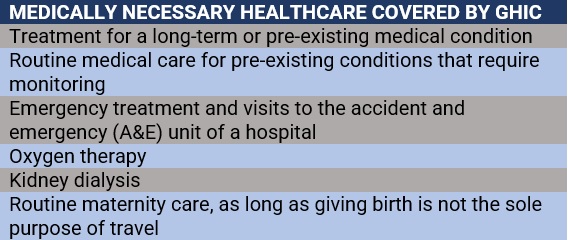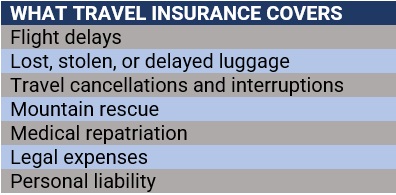

The Global Health Insurance Card (GHIC) is set to replace the European Health Insurance Card (EHIC), which is being phased out following the nation’s departure from the European Union (EU). Launched at the start of 2021, the GHIC still gives UK nationals access to free or discounted medical care while travelling across Europe, with slight variations from what the new EHIC offers.
To help British citizens and residents understand the level of coverage the GHIC provides, Insurance Business answers the most common questions regarding this vital health insurance card. We will explain how the GHIC works, what kinds of benefits it offers, and in which countries you can access healthcare.
If you’re trying to figure out if the GHIC is worth getting, this guide can help you make an informed decision. Insurance professionals can also use this piece as a starting point for discussing with their clients the importance of taking out proper coverage when travelling abroad. Here’s everything you need to know about the Global Health Insurance Card.
The Global Health Insurance Card and the existing European Health Insurance Card have essentially the same function. They both give UK nationals access to state-provided medical care for free or at a reduced rate in any EU-member country and Switzerland.
The GHIC was rolled out on 01 January 2021 as part of the Brexit agreement. For most people living in the UK, it will replace the old EHIC, which is currently being phased out. Existing EHICs are set to expire within four years, after which British citizens who will apply for renewal will be issued a GHIC. Cardholders, however, can still use their EHICs to access the same benefits until the expiry date.
According to the National Health Service (NHS), UK citizens can access “medically necessary, state-provided healthcare” if they are travelling to an EU country or Switzerland.
The NHS adds that medically necessary healthcare pertains to treatments and procedures “that cannot reasonably wait until you can come back to the UK.” Whether a treatment is considered necessary depends on the healthcare provider in the nation you are visiting.
Here are examples of procedures and treatments considered necessary, according to the NHS:

The Global Health Insurance Card, however, does not guarantee free coverage as each country implements a different healthcare system. This means that a procedure that can cost you nothing in one country may require you to pay out-of-pocket in another.
GOV.UK’s foreign office country guide gives you a nation-by-nation breakdown of the different medical treatments you can access through your GHIC or existing EHIC.
With GHIC’s introduction, your current EHIC will no longer be renewed. The Global Health Insurance Card will replace your existing EHIC if you are:
UK dual citizens are usually eligible for a GHIC. These include dual nationals living in the country and jointly holding British and EU, Swiss, Norwegian, Liechtenstein, or Icelandic citizenship. However, you may qualify for a new EHIC if you meet the following criteria:
If you were born in the UK to British parents or parents who were settled and have lived in the country before 01 January 2021, then you will be issued a GHIC upon renewal, even if you hold EU, Swiss, Norwegian, Icelandic or Liechtenstein citizenship. This also applies to people from Northern Ireland, who hold Irish citizenship.
There are still people living in the UK who can apply for a new EHIC. The new European Health Insurance Card is identifiable by a Union flag hologram in the top-right corner. It gives the holder free or discounted healthcare in all EU nations, Switzerland, Norway, Iceland, and Liechtenstein. To learn more about European Health Insurance Card, check it out in this article.
You may apply for the new EHIC if you meet one of these requirements:
Residents in Ireland may also qualify for a new EHIC if they are:
You can use your GHIC to access full or partial healthcare coverage in the following three groups of countries:
The European Union consists of 27 countries. In the table below, you can find the links to each nation’s European Commission website, detailing how you can use your GHIC to get medical care and treatment.
|
GLOBAL HEALTH INSURANCE CARD (GHIC) COUNTRY-BY-COUNTRY GUIDE |
||
|---|---|---|
In Switzerland, you need to meet one of the following criteria to be able to use your GHIC or existing EHIC:
You may also be asked to show evidence of your citizenship before you can use your Global Health Insurance Card to access healthcare services.
One of the biggest changes brought about by Brexit is that the GHIC and most EHICs no longer provide UK citizens with the coverage they previously enjoyed in these three countries. To get state-sponsored medical treatment from there, you will need to have the new European Health Insurance Card.
However, you can still use your existing EHIC if you were already in these countries before 01 January 2021. If that’s the case, your EHIC is valid until you leave, as long as it hasn’t expired. Norway also gives UK passport holders access to medically necessary healthcare for free or at a discounted cost, just like a local.
No. The “global” scope of your Global Health Insurance Card is limited to EU member states and Switzerland. The UK, however, has reciprocal healthcare agreements with several non-EU nations, allowing you to access medical care if you’re travelling there. Each country has its own requirements but typically you will be asked to present proof of British citizenship such as a passport. Your GHIC or EHIC is not necessary.
The table below list the countries and jurisdictions which the UK has reciprocal healthcare agreements with, along with the links to GOV.UK’s healthcare guide.
|
UK’s RECIPROCAL HEALTHCARE AGREEMENTS (NON-EU COUNTRIES) |
|
|---|---|
Yes, if you do not live in the UK. The GHIC and EHIC are not valid in your country of residence. If you’re a UK resident and in need of medical care, you can access treatments and services for free through the NHS, the nation’s publicly funded healthcare system.
You can learn more about the UK’s healthcare system, as well as those of other countries, in our global health insurance guide.
You can get a GHIC and EHIC FREE OF CHARGE! This is what the UK government has repeatedly emphasised, especially after a recent poll conducted by the travel insurance specialist Direct Line revealed that cost was among the top reasons preventing Brits from taking out a Global Health Insurance Card.
Respondents mistakenly believe that they need to pay to have their EHICs replaced by a GHIC, with the average cost thought to be £9.30. According to the survey, this was likely the result of several unscrupulous websites asking applicants for payment.
The introduction of the Global Health Insurance Card has led to criminals creating fake sites to charge upfront fees for your application.
— FraudWatch By ERVAS (@FraudWatchUK) May 12, 2021
Remember the GHIC, which replaces the European Health Insurance Card, is FREE to use & can only be obtained 👇https://t.co/wrm9i9tEoP pic.twitter.com/vxNtcMYkox
The government reminds UK citizens to use only the NHS website when applying for the GHIC. Again, APPLYING FOR A GHIC IS ABSOLUTELY FREE! During application, you will be asked to provide the following information:
You must also be at least 16-years old to apply and will need to create an account using the NHS form. Those below 16-years old will need a parent or guardian to apply on their behalf.
Do not use websites that charge you a fee to help you with the application process – these are deceitful and fraudulent.
It can take up to 15 working days after the application for your GHIC to arrive. If you already have your Global Health Insurance Card and it’s lost or stolen, you can request a replacement using the NHS website.
Your Global Health Insurance Card is valid for five years. You can apply for a replacement as early as six months before your current GHIC expires.
If there’s an emergency while you’re travelling abroad and you don’t have your Global Health insurance Card with you, then you will need to secure a Provisional Replacement Certificate (PRC) to access treatment. The PRC offers the same coverage as your GHIC.
You can apply for a PRC through the NHS Overseas Healthcare Services. You will be asked to provide the following details during the application:
If you’re not able to apply for a PRC yourself, someone else can do it on your behalf.
It is not mandatory for you to get a GHIC if you’re travelling overseas, although some insurers may make it a condition for taking out travel insurance. The UK government also reminds citizens that your GHIC cannot replace the level of protection a standard travel insurance policy provides.
While your Global Health Insurance Card can be used in medical emergencies, it does not cover all treatments and healthcare services and other eventualities a travel policy is designed for. These coverages are listed in the table below.

Instead of viewing the Global Health Insurance Card as a substitute for travel policies, it’s better to treat it as a complement to travel insurance plans.
Your GHIC also covers healthcare and treatment related to COVID-19, but so do most travel insurance policies. Check out the different coronavirus-related coverages the UK’s top travel insurers offer in this guide.
Do you have any experience in using your Global Health Insurance Card while travelling abroad? We’d love to hear your story in the comment section below.
